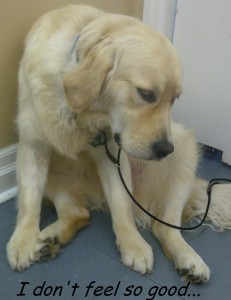 Did you know that a lot of chronic vomiting and diarrhea in pets can be traced back to a leaky gut lining?
Did you know that a lot of chronic vomiting and diarrhea in pets can be traced back to a leaky gut lining?
When the gut lining has gaps between its cells, it means proteins from the diet can get presented directly to the immune system cells. The result can be that the immune cells can have what amounts to an immunologic hissy-fit – they send out a bunch of signals to initiate inflammation. Inflammatory cells make their way into the stomach and intestines, and the result is vomiting, diarrhea and sometimes weight loss.
Now, did you know that tiny little bacteria can help with this?
Think about how you use conditioner to keep your hair healthy; well, the “good guy” bacteria found in Probiotics produce VFAs (Volatile Fatty Acids) which are “conditioner” for intestinal cells. Once the cells have become nicely thick and full-bodied, they pack tightly, cheek-by-jowl, and seal up the gaps. This effect can help not only in the gut, but in other parts of the body affected by immune-system mistakes, such as asthmatic lungs; decreasing the overall level of immune-cell stimulation with probiotics can actually decrease the severity of asthma symptoms.
Probiotic bacteria have another useful effect, which is to crowd out the “undesirables”. In many cases, a sudden bout of diarrhea in an otherwise healthy pet is the result of an imbalance in the gut bacteria population, know as a “dysbiosis”. This imbalance can be set off by the overproduction of acid in the gut environment – the acid kills off the “good guy” bacteria, but spares the “bad guys”. The “bad guy” bacteria produce waste products that are highly irritating to the gut lining, and the result is an often mucoid and sometimes blood-tinged diarrhea.
So why did the gut environment end up acidic? This can be from:
- “Dietary Indiscretion”, also known as “Garbage Gut”. If lots of nutrients make it past the Small Intestine unused, either because there was too much to process or because it was an unaccustomed food that the pet’s system is not set up to digest, then all that undigested goodness makes it through to the bacteria that live in the Large Intestine. The waste products that result from this bacterial Smorgasbord are very acidic.
- High levels of stress hormones, such as cortisol. This is what happens when a dog gets “Kennel Diarrhea” – a boarded dog is excited, and spends the whole day barking, and before you know it he is barking out of one end and squirting unmentionable mess out of the other. These dogs are usually not ill – their energy and appetite tends to stay OK.
- Inflammation. If inflammation is started by something else, such as a parasite or the bacteria from food-poisoning, the inflammation itself produces an acidic environment. In this way, the problem becomes self-perpetuating – even after the cause of the inflammation is treated, the diarrhea can persist unless the dysbiosis is corrected.
So, how do we go about restoring this scorched-earth gut environment to a happy place for bacteria to live and digest?
- We could attack the undesirable “bad guy” bacteria with antibiotics. Some antibiotics such as Metronidazole and Tylosin do a great job of removing the bad and preserving the good bacteria. (Side note: this is why I do not like the product “Angel Eyes” – it contains the antibiotic Tylosin. The idea is that the discoloured tear tracks on the face are reduced by having antibiotic secreted right in the tears, to kill off the bacteria that digest a tear component to make the orange-brown colour. Using any antibiotic a lot breeds bacterial resistance – and Tylosin is one of the best anti-diarrheal antibiotics we have!)
- We could out-compete the “bad guy” bacteria. Probiotics are “good-guy” bacteria “reinforcements”, to help repopulate the gut with the bacteria that we do want. In a lot of Probiotic products, the bacteria are coated with special sugars called FOS’s (Fructooligosaccharides) – also referred to as PREbiotics. These serve 2 purposes:
*They are protective armour to help the bacteria survive past the first defense of the gastrointestinal system,the vat of hydrochloric acid also know as The Stomach.
*They are a fuel source that the “good guy” bacteria have the right kind of enzyme to use, but “bad guys” don’t. This means not only are they food for the bacteria that were in the Probiotic,they are rations getting delivered to “good guy” bacteria that had managed to survive so far in the gut.
While Probiotics help restore the gut bacterial population to its desirable balance, ultimately we do need to address whatever knocked it out of kilter in the first place. If dietary sensitivity plays a part, then the key is to stop exposing the pet’s system to that component by changing the diet. If a parasite is present, we want to eliminate it.
